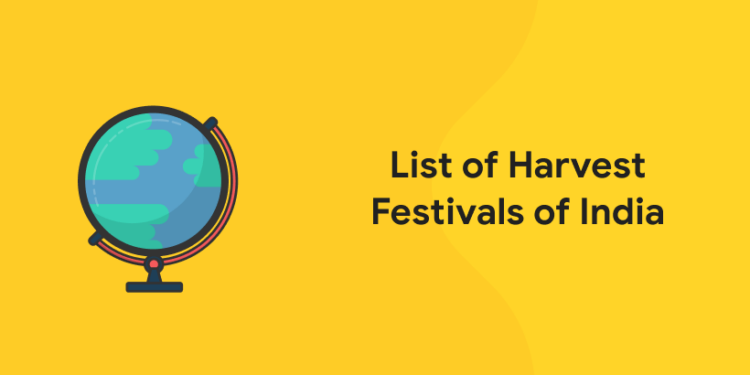Table of Contents
Hearing the name harvest festival, memories might have rushed into your active brain right? It is the part and parcel of the cultural life of the Indian people. India’s cultural heritage is visible in the harvest festivals. The harvest festivals are the heartbeat of the Indian lives. The harvest festivals celebrate the unity, joy, harmony, and self-sufficiency of the Indian population. India is the abode of celebrations, a rich homeland sufficed with joyful occasions and intriguing mythical tales. Harvest festivities are occasions that abide during a province’s immediate reaping. India’s 28 states celebrate harvest festivals at the different times of the year because of the climatic differences and the availability of rain. The main crops are supposed to be reaped in a particular season and this is made possible through the constant and unified efforts of the people in the particular region. India is widely known for its harvest festivals. The Indians are proud as the land is called the motherland of festivals which is regarded as a luminous nation where individuals commemorate with complete passion and delight. The foremost harvest of the yield is a satisfaction for the individuals and they observe it heartily as a celebration.
| The Harvest Festival | States |
| Vishu | Kerala and Karnataka |
| Onam | Kerala |
| Pongal | Tamil Nadu |
| Makar Sakranti | Gujarat, Kerala, Tamil Nadu, Haryana, Himachal, West Bengal, and Punjab |
| Bohag Bihu | Assam |
| Nuakhai | Orissa |
| Nabanna | West Bengal |
| Wangala | Meghalaya and Assam |
| Ka Pomblang Nongkrem | Meghalaya |
| Baisakhi/ Vaisakhi | Punjab and Haryana |
| Ladakh Harvest Festival | Ladakh, Zanskar and Kargil |
| Lohri | Punjab |
| Gudi Padwa | Maharashtra, Karnataka, and Andhra Pradesh |
Carnivals have always been the most outstanding and favored domain of a visitor’s travel through other nations and mainland. The considerable echoing crop festivals of India concern intriguing mythic parables and festive carnivals. They are as remarkable and miscellaneous as their people and geographies and let you partake in the attractiveness of the Indian culture.
Ace to aether industries here!
The harvest seasons are meant to be the thankful plentiful harvest. The names and places may vary but the exact meaning that revolves around the harvest festivals is the gratitude that the people of a country are showing for bestowing a blessing upon the country. The plentiful harvest of a particular season is a joyous occasion for the citizens. A sizable balance of the Indian inhabitants is vigorously committed to pastoral stirs. The first crop of their unexplored yield is a content juncture for them.
It is a juncture to honor the nutrition that has been grown. The harvest festivals are the occasions that cater to the well-being of a group of citizens in the country. The seasons and the changes can affect the cultivation. The harvest season is a blissful season of the year. Let’s know more about the harvest festivals in India.
List of Harvest Festivals in India
Harvest celebrations may be found in miscellaneous terms in further locations across the world due to discrepancies in weather and yields. The major harvest festivals celebrated in India are as follows. The enthusiastic learners can use the below-furnished information to know more about the harvest seasons and the festivals associated with them.
Makar Sakranti
1: Who was the first woman President of India?
Makar Sankranti is India’s most geriatric and most kaleidoscopic reaping festival, observed across the nation. Hindu mythology states that the Makar Sakranti festival symbolizes the rear of a destructive stage and the commencement of an exemplary stage in the lives of the Indian population. People in Kerala, Punjab, Tamil Nadu, Haryana, Himachal Pradesh, West Bengal, and Gujarat honor the reaping of new harvests with bonfires, extravaganzas, melody, proms, kite aviation, and meetups. Makar Sankranti celebrates the sun’s appearance in the zodiac symbol of Makara (Capricorn) as it proceeds along its starry passage. It is commemorated in diverse states with distinguishable reputations. For instance, in Gujarat, since 1989 Uttarayan is the International Kite festive is observed as part of the authorized extravaganza of ‘Uttarayan’. Maghi in Punjab is the festival associated with it when soaking in a river in the earlier daybreak hours of Maghi is paramount. Magha months’ beginning is celebrated in Himachal Pradesh as Magha Sanji. Kitchen In Uttar Pradesh is yet another celebration that entangles ceremonious bathing in the river body. The Pongal is Tamilnadu is observed over 4 daytimes at reaping time. The Kumbh Mela is popular and the presence of the delicious precious foodstuffs consisting of sesame and jaggery are the primary inducements of the Makar Sankranti festival.
Know more about phonetics here!
Free UPSKILLING Courses!
Take your first step toward mastering in-demand skills, acing interviews, and securing top-tier jobs with Entri's free upskilling courses.
Start Learning!Bohag Bihu
Annually, in April, the entire state of Assam observes Bohag Bihu with ardency and delight. It designates the commencement of the Assamese new year. It is believed that the occasion started when the ravine’s residents commenced cultivating the land. Bihu is assumed to be as ancient as the Brahmaputra River. This is an impressive and multicolor moniker on the checklist of reaping festivals in India, also understood as Magh Bihu. Growers in Assam delight and want their harvesting measures and obtain the blessings. Uruka, the collective dinner, boots of the revelries the night back. On Bihu, the media or pavilions, made of clay and silage, are charred. Regional women outfit in splendid mukhtars and endure in communal nature of the dancing and signing. The mirth of gathering together as a community is evident in such instances. Bihu celebration highlights include the Sunga Pitha, Til Pitha, and Laru, Bihu hop, bullfight, cock fight, etc.
Baisakhi/ Vaisakhi
Baisakhi or Vaisakhi is observed in Punjab and Haryana by showing gratitude to God for a fruitful harvest. Men’s Bhangra and women’s Giddha are the principal appeals of the Baisakhi extravaganza. The agriculturalists communicate their delight and pleasure by commemorating this Indian yield celebration. People wrap up in their most kaleidoscopic ensembles, pipe the delighted melodies, and hop to the melodious sounds of Dhol. There are also Baisakhi fairs where fireworks, twisting, and vanilla actions are also detected. The celebrations are the best ways to show gratitude towards nature for the harvest and the fertility of the land.
Nabanna
The festival is part of the daily existence of the Bengali people. The celebration is related to the cultural life of the Bengali people too. The carnival is observed in West Bengal. The primary interests of the Nabanna carnival are Nabanna fair and Payesh (Kheer) boiled from freshly reaped rice. Bengal’s most acknowledged festivals, in which new rice is gathered with delight and stowed in families. Growers from Bengal joyfully encounter this reaping ritual during the Bengali month of Agrahayan, showing the preferably grains to Goddess Lakshmi and thanking her for all usefulness.
Free UPSKILLING Courses!
Take your first step toward mastering in-demand skills, acing interviews, and securing top-tier jobs with Entri's free upskilling courses.
Start Learning!Nuakhai
Nuakhai is an antique reaping festival observed in Orissa. Nuakhai Parab or Nuakhai Bhetghat are supplementary manifestations for the harvest celebration.’ Nua’ suggests uniqueness in the aboriginal speech, while ‘Khai’ suggests nourishment. The old and wicked days are considered evil and the festival is a bidding farewell to the past miseries. Welcoming the new era with love and joy is the main attraction of the harvest festival. The delicious Arsaa Pitha is ready to memorialize the celebration.
Ladakh Harvest Festival
The festival is observed in Ladakh, Zanskar and Kargil. With the beginning of this crop celebration, Ladakh appears luminous, stunning and particularly fetching. The Ladakh Yeilding festive has obtained worldwide glory and favor. Sanctuaries and stupas are decorated, and expeditions to the Thangka of Kyabje Gombo are mandated as part of the celebration of the festival in all its mirth. The historical, social, and cultural events that are part of the festival. The archery and handicrafts are the major attractions of this event. Dramas, or ‘Chhams,’ are perpetrated to illustrate Buddha’s vitality and pedagogy, as well as other dance classes from Tibetan culture. They are the central appeal of the celebration. The culture of the region is demonstrated with the use of the dramas. The historical significance that is connected to the festival makes it even more appealing to the audience.
Lohri
Lohri is a famous harvest festival in Punjab that brings forth traditional hop and harmony. It celebrates the closing of the winter season and is chronological, as part of the history, expressed to guide the recovery of the sun to the northern hemisphere. To defeat the winter cold, the whole household and neighbors assemble about a campfire and pipe concurrently, delivering kernels, grains, and nuts to celebrate and relish the astonishing yield of sugarcane yield. The Punjabi standard Sunder Mundriye is one of the celebration’s primary allures. It is observed the nighttime before Makar Sankranti. The celebration of togetherness is possible only through finding the right essence for the celebration.
Onam
Onam is a historical yield festival in Kerala that is observed with immense ardency in different parts of the state. With the arrival of Mahabali, the celebration stays ten daylights. The Onam is celebrated with much zeal. The Onam is part of teh mythology and teh mythical story associated with it is quite fascinating. The presence of the traditional wear, traditional food practices, and the traditional customs is the part of teh Onam celebration. One is celebrated with happiness. The festival of Onam is also a season of gathering and the concepts of togetherness and harmony are celebrated with much vigor. People commemorate the successful yield by embellishing their home entrance with blossom rangoli, fraying new conventional ensembles, boiling incredible meals, and observing with traditional essence. Traditional Malayalee foodstuffs such as Rasam, Payasam, Avial, brown rice, and parippu curry are suited to visitors in traditional plantain leaf, and the serpent boat race and barracuda dance are enormously satisfying to glimpse. The name is also a celebration of the traditional customs of eating and merry together without any religious barriers.
Ka Pomblang Nongkrem
It is specially commemorated in Meghalaya. The occasion possesses creature surrender and the Nongkrem dance, which is accomplished with a blade in one hand and a yak hair whisk in the other. The people of the Khasi cliffs revere Goddess Ka Blei Synshar. It is acknowledged that Ka Pomblang Nongkrem supplies the neighborhood with the most enjoyment and contentment. People observe the generous harvest with incredible eagerness and enthusiasm. The two main components of the Ka Pomblang Nongkrem extravaganza are the Pemblang practice and the Tangmuri ritual.
Pongal
Pongal is the other phrase for Makar Sankranti, which is observed in many metropolitan in Tamil Nadu too. Pongal represents ‘downpour‘ or ‘simmering over.’ This is a thanksgiving celebration in which individuals deliver their honest appreciation to Mother Nature for the year’s rice reaping. This is one of India’s most kaleidoscopic reaping festivities, enduring four days. The first day is the Bhogi Festival, which is earmarked to Lord Indra in interaction for a quantity of precipitation. The newly gathered rice and milk are designed and delivered to the Sun God outdoors on the second day of celebration. The third day is committed to cow worship. The fourth day is committed to Pongal, or classic colored rice spiced with turmeric, betel leaf, and betel nuts. Tamilians celebrate the affair by assembling traditional designs known as kolams employing rice powder in their homes. Pongal festivity highlights also include bull-taming contests and bone fire aimed at the invoking of the god almighty. The togetherness of the family and the prosperity of life is the major aspect of the Pongal. It is celebrated with enthusiasm.
Vishu
Vishu is the celebration of Kerala and Karnataka. This is a charming harvest occasion maintained on the foremost day of the Malayalee New Year. Females in the residence chef Vishukkani, which consists of rice, golden cucumber, jackfruit, yellow konna flowers, betel leaves, and golden lemon. The celebration is characterized by the lavish glorification of Lord Vishnu or Lord Krishna, luxury lineage lunches, nocturnal devotions, and fireworks. The primary magnets of the Vishu festival are Vishnu’s first sacred sight and Sadya, Kani Kanal. Vishu is celebrated by Keralites irrespective of caste or religion.
Gudi Padwa
Gudi Padwa is a splendid festival marked in Maharashtra to observe the beginning of a booming New Year. The celebration is also honored in Karnataka and Andhra Pradesh and is anointed Ugadi. Gudi Padwa has also believed in the harvest carnival, which displays that the rabi harvest has ceased for the season. This is the time when mangoes and other fruits are reaped. Individuals assemble rangoli designs and embellish them with blossoms and a handwrought knockout at the doorway of their residences. People congregate with pals and households to suggest salutations and women qualify as confectionaries.
Entri App can help the candidates to know more about the general affairs. Those candidates who are eagerly waiting for the exam updates can depend upon the Entri App to ease the situation. Any of the competitive exams demand materials that can help the candidates a lot. The learners can use the Entri App to learn from experts. The Entri expert team provides materials, notes, and live sessions that can help them to revive their knowledge and to face the exam with confidence. The performance potential of the candidates can be boosted with the help of the expert team, it is the greatest boon. Download Entri App and give color to your dreams. The Entri App can help you to learn better.
Attempt a quiz! Download Entri App here!












